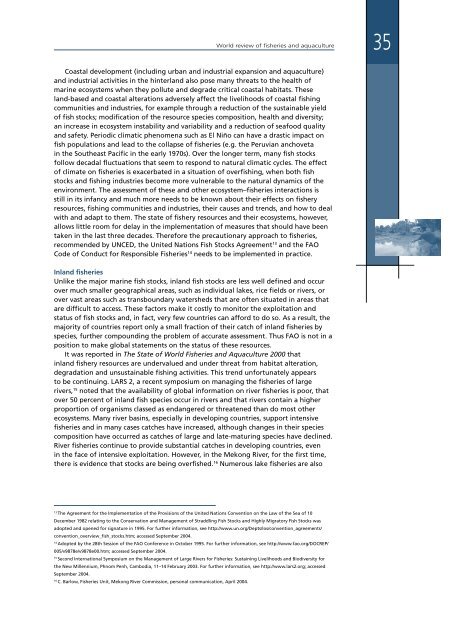State of World Fisheries and Aquaculture 2004 - Library
State of World Fisheries and Aquaculture 2004 - Library
State of World Fisheries and Aquaculture 2004 - Library
You also want an ePaper? Increase the reach of your titles
YUMPU automatically turns print PDFs into web optimized ePapers that Google loves.
<strong>World</strong> review <strong>of</strong> fisheries <strong>and</strong> aquaculture<br />
35<br />
Coastal development (including urban <strong>and</strong> industrial expansion <strong>and</strong> aquaculture)<br />
<strong>and</strong> industrial activities in the hinterl<strong>and</strong> also pose many threats to the health <strong>of</strong><br />
marine ecosystems when they pollute <strong>and</strong> degrade critical coastal habitats. These<br />
l<strong>and</strong>-based <strong>and</strong> coastal alterations adversely affect the livelihoods <strong>of</strong> coastal fishing<br />
communities <strong>and</strong> industries, for example through a reduction <strong>of</strong> the sustainable yield<br />
<strong>of</strong> fish stocks; modification <strong>of</strong> the resource species composition, health <strong>and</strong> diversity;<br />
an increase in ecosystem instability <strong>and</strong> variability <strong>and</strong> a reduction <strong>of</strong> seafood quality<br />
<strong>and</strong> safety. Periodic climatic phenomena such as El Niño can have a drastic impact on<br />
fish populations <strong>and</strong> lead to the collapse <strong>of</strong> fisheries (e.g. the Peruvian anchoveta<br />
in the Southeast Pacific in the early 1970s). Over the longer term, many fish stocks<br />
follow decadal fluctuations that seem to respond to natural climatic cycles. The effect<br />
<strong>of</strong> climate on fisheries is exacerbated in a situation <strong>of</strong> overfishing, when both fish<br />
stocks <strong>and</strong> fishing industries become more vulnerable to the natural dynamics <strong>of</strong> the<br />
environment. The assessment <strong>of</strong> these <strong>and</strong> other ecosystem–fisheries interactions is<br />
still in its infancy <strong>and</strong> much more needs to be known about their effects on fishery<br />
resources, fishing communities <strong>and</strong> industries, their causes <strong>and</strong> trends, <strong>and</strong> how to deal<br />
with <strong>and</strong> adapt to them. The state <strong>of</strong> fishery resources <strong>and</strong> their ecosystems, however,<br />
allows little room for delay in the implementation <strong>of</strong> measures that should have been<br />
taken in the last three decades. Therefore the precautionary approach to fisheries,<br />
recommended by UNCED, the United Nations Fish Stocks Agreement 13 <strong>and</strong> the FAO<br />
Code <strong>of</strong> Conduct for Responsible <strong>Fisheries</strong> 14 needs to be implemented in practice.<br />
Inl<strong>and</strong> fisheries<br />
Unlike the major marine fish stocks, inl<strong>and</strong> fish stocks are less well defined <strong>and</strong> occur<br />
over much smaller geographical areas, such as individual lakes, rice fields or rivers, or<br />
over vast areas such as transboundary watersheds that are <strong>of</strong>ten situated in areas that<br />
are difficult to access. These factors make it costly to monitor the exploitation <strong>and</strong><br />
status <strong>of</strong> fish stocks <strong>and</strong>, in fact, very few countries can afford to do so. As a result, the<br />
majority <strong>of</strong> countries report only a small fraction <strong>of</strong> their catch <strong>of</strong> inl<strong>and</strong> fisheries by<br />
species, further compounding the problem <strong>of</strong> accurate assessment. Thus FAO is not in a<br />
position to make global statements on the status <strong>of</strong> these resources.<br />
It was reported in The <strong>State</strong> <strong>of</strong> <strong>World</strong> <strong>Fisheries</strong> <strong>and</strong> <strong>Aquaculture</strong> 2000 that<br />
inl<strong>and</strong> fishery resources are undervalued <strong>and</strong> under threat from habitat alteration,<br />
degradation <strong>and</strong> unsustainable fishing activities. This trend unfortunately appears<br />
to be continuing. LARS 2, a recent symposium on managing the fisheries <strong>of</strong> large<br />
rivers, 15 noted that the availability <strong>of</strong> global information on river fisheries is poor, that<br />
over 50 percent <strong>of</strong> inl<strong>and</strong> fish species occur in rivers <strong>and</strong> that rivers contain a higher<br />
proportion <strong>of</strong> organisms classed as endangered or threatened than do most other<br />
ecosystems. Many river basins, especially in developing countries, support intensive<br />
fisheries <strong>and</strong> in many cases catches have increased, although changes in their species<br />
composition have occurred as catches <strong>of</strong> large <strong>and</strong> late-maturing species have declined.<br />
River fisheries continue to provide substantial catches in developing countries, even<br />
in the face <strong>of</strong> intensive exploitation. However, in the Mekong River, for the first time,<br />
there is evidence that stocks are being overfished. 16 Numerous lake fisheries are also<br />
13<br />
The Agreement for the Implementation <strong>of</strong> the Provisions <strong>of</strong> the United Nations Convention on the Law <strong>of</strong> the Sea <strong>of</strong> 10<br />
December 1982 relating to the Conservation <strong>and</strong> Management <strong>of</strong> Straddling Fish Stocks <strong>and</strong> Highly Migratory Fish Stocks was<br />
adopted <strong>and</strong> opened for signature in 1995. For further information, see http://www.un.org/Depts/los/convention_agreements/<br />
convention_overview_fish_stocks.htm; accessed September <strong>2004</strong>.<br />
14<br />
Adopted by the 28th Session <strong>of</strong> the FAO Conference in October 1995. For further information, see http://www.fao.org/DOCREP/<br />
005/v9878e/v9878e00.htm; accessed September <strong>2004</strong>.<br />
15<br />
Second International Symposium on the Management <strong>of</strong> Large Rivers for <strong>Fisheries</strong>: Sustaining Livelihoods <strong>and</strong> Biodiversity for<br />
the New Millennium, Phnom Penh, Cambodia, 11–14 February 2003. For further information, see http://www.lars2.org; accessed<br />
September <strong>2004</strong>.<br />
16<br />
C. Barlow, <strong>Fisheries</strong> Unit, Mekong River Commission, personal communication, April <strong>2004</strong>.

















